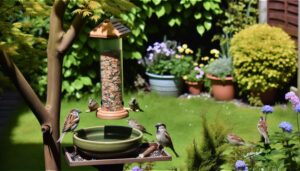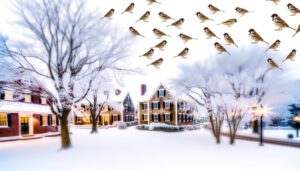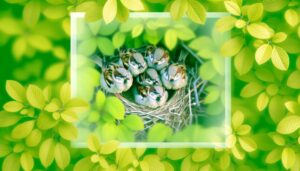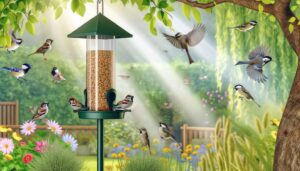Learn to Say ‘House Sparrow’ in German – A Quick Guide
The German term for "house sparrow" is "Haussperling." This compound word integrates "Haus" (house) and "Sperling" (sparrow), alluding to the bird's adaptation to human environments. Pronounced [ˈhaʊsˌpɛrlɪŋ], it demonstrates the precise stress patterns characteristic of German.
In regional dialects, you may encounter variations such as "Spatz" in Bavarian. The house sparrow holds cultural significance, symbolizing resilience and commonality, and features prominently in German literature and ecology.
To gain deeper insights into its cultural and linguistic nuances, as well as its significance in birdwatching practices, exploring further is beneficial.
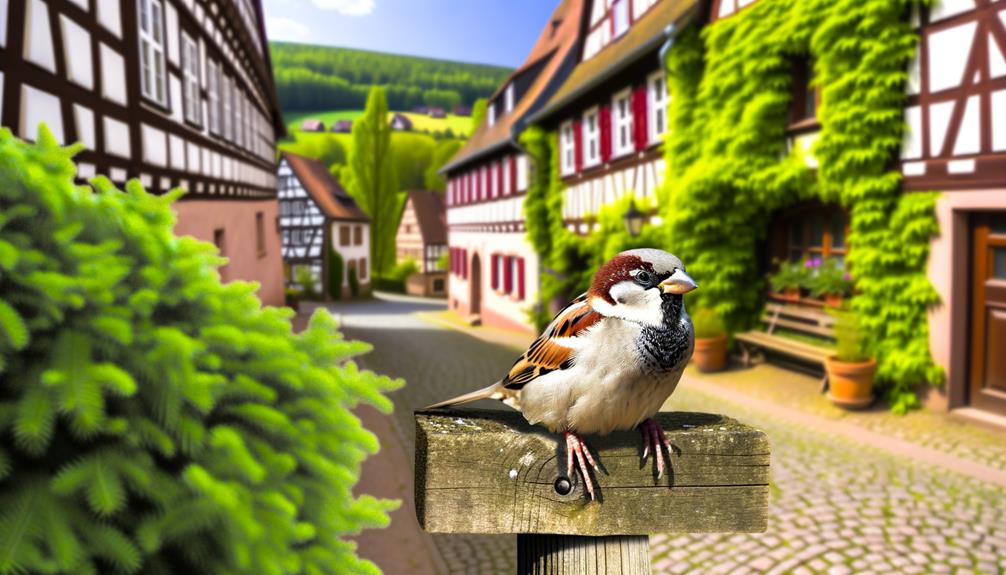
Key Takeaways
- The term for House Sparrow in German is 'Haussperling'.
- 'Haussperling' is a compound word combining 'Haus' (house) and 'Sperling' (sparrow).
- Pronounce 'Haussperling' as [ˈhaʊsˌpɛrlɪŋ] with stress on 'Haus'.
- In Bavarian dialect, House Sparrow is called 'Spatz'.
- In Swabian dialect, House Sparrow can also be referred to as 'Sperling'.
The German Word for House Sparrow
The German word for house sparrow is 'Haussperling,' which directly translates to 'house sparrow' in English. This compound word combines 'Haus,' meaning 'house,' and 'Sperling,' meaning 'sparrow.'
In examining this term, we observe a straightforward linguistic construction where 'Haus' signifies the bird's common habitat, while 'Sperling' identifies its species. This terminology is emblematic of the German language's tendency toward descriptive compound nouns.
Culturally, the house sparrow holds a similar place in German-speaking countries as it does in English-speaking ones, often associated with urban and rural environments alike. Understanding 'Haussperling' provides insight into both the linguistic structure of German and its cultural parallels with English regarding common wildlife.
Pronouncing Haussperling Correctly
To accurately pronounce 'Haussperling,' it is important to break down the word into its constituent parts and understand the phonetic elements of German pronunciation. German phonetics can be challenging, but mastering them enhances communication and cultural appreciation. The word 'Haussperling' is comprised of two parts: 'Haus' and 'Sperling.' Understanding the distinct sounds of each part is vital.
| Sound | German Pronunciation | English Equivalent |
|---|---|---|
| Haus | /haʊs/ | Like 'house' in English |
| Sper | /ʃpɛr/ | 'shper' with emphasis on 'sh' |
| ling | /lɪŋ/ | Like 'ling' in 'darling' |
These phonetic elements reflect the precision and rhythm characteristic of the German language, enhancing your linguistic competence and cultural immersion.
Breaking Down the Word
The German term 'Haussperling' is composed of two elements: 'Haus' meaning house and 'Sperling' meaning sparrow, reflecting the bird's common habitation in human settlements.
The pronunciation follows standard German phonetics, emphasizing clear articulation of each syllable.
Understanding the etymology and pronunciation provides a foundation for appreciating its contextual usage in German-speaking cultures.
Etymology of the Term
Examining the etymology of the German term for house sparrow, 'Haussperling,' reveals insights into both linguistic structure and cultural significance.
The compound word 'Haussperling' is formed by merging 'Haus,' meaning dwelling, and 'Sperling,' denoting sparrow. This linguistic construction indicates the bird's close association with human habitation, reflecting its common presence in urban and rural areas alike.
'Haus' is derived from Old High German 'hūs,' while 'Sperling' originates from Middle High German 'sperlinc,' rooted in Proto-Germanic '*sparwa-.' The term underscores the species' adaptation to anthropogenic environments, highlighting a cultural recognition of the bird's role in human ecosystems.
Therefore, 'Haussperling' exemplifies how language encapsulates both ecological relationships and historical linguistics.
Pronunciation Guide
Understanding the pronunciation of 'Haussperling' requires a detailed breakdown of its phonetic components, reflecting its etymological roots and cultural resonance.
The word 'Haussperling' is articulated as [ˈhaʊsˌpɛrlɪŋ], where 'Haus' [haʊs] mirrors the English 'house' and 'sperling' [ˈspɛrlɪŋ] combines 'sper-' with a rolling 'r' and the diminutive 'ling'.
The initial 'H' is pronounced clearly, followed by the diphthong 'au' which sounds like 'ow' in 'now'. The 's' at the end of 'Haus' is crisp, shifting into 'sperling' where 'sp' is pronounced as in 'spare'.
Emphasizing the primary stress on 'Haus' and secondary on 'sperling' guarantees accurate articulation. This phonetic precision aligns with the German linguistic tradition, underscoring both clarity and cultural specificity.
Contextual Usage
Delving into the contextual usage of 'Haussperling', one finds that the term seamlessly integrates into German conversations about common avian species, particularly in urban and suburban settings. The word is often encountered in various contexts, reflecting its relevance in everyday communication.
- Ecology discussions: Used in conversations about biodiversity and urban wildlife.
- Birdwatching: Essential in field guides and casual birdwatching activities.
- Cultural references: Appears in idiomatic expressions and local folklore.
- Educational material: Found in textbooks and children's literature about nature.
- Conservation efforts: Integral to discussions on preserving bird habitats.
The term 'Haussperling' holds significant value, not only linguistically but also culturally, illustrating the bird's prominence in German-speaking regions.
Regional Variations
Across various regions of Germany, the term for 'house sparrow' can differ greatly, reflecting the country's diverse linguistic landscape. In standard German, it is commonly known as 'Haussperling.' However, regional dialects introduce notable variations.
In Bavarian dialect, it is referred to as 'Spatz,' while in Swabian, it might be called 'Sperling.' These variations are more than mere linguistic curiosities; they reflect the cultural and historical influences that shape regional identities.
For instance, 'Spatz' in Southern Germany also carries connotations of endearment, often used affectionately in colloquial speech. Understanding these regional terms provides valuable insight into the intricate relationship between language, culture, and geography in Germany, enhancing one's appreciation of the country's rich linguistic tapestry.
House Sparrow Description
The House Sparrow, known as 'Haussperling' in German, is characterized by its stout body, short tail, and distinctive plumage, including a brown and grey feather pattern. Commonly found in both urban and rural environments, this species exhibits a versatile range of behaviors from foraging in human-inhabited areas to nesting in crevices.
Understanding the specific attributes and ecological adaptations of the House Sparrow provides valuable insights into its cultural and environmental significance in various German-speaking regions.
Identification and Features
Characterized by its stout body, short tail, and robust beak, the House Sparrow (Passer domesticus) is a small bird species with distinct and easily identifiable features. This ubiquitous avian exhibits sexual dimorphism, with males and females displaying differing plumage.
- Males: Notable for their gray heads, white cheeks, and distinctive black bibs.
- Females: More subdued in appearance, featuring brown and gray streaks.
- Wings: Both sexes have brown wings with white bars.
- Size: Typically measures around 14-16 cm in length.
- Weight: Weighs approximately 24-39 grams, contributing to their agile flight.
These attributes, combined with their vocal chirping, make the House Sparrow a recognizable and culturally significant bird across various regions.
Habitat and Behavior
Beyond its physical characteristics, the House Sparrow is known for its adaptability, thriving in diverse habitats ranging from urban environments to rural landscapes.
This bird species, Passer domesticus, exhibits remarkable versatility, nesting in crevices of buildings, under eaves, and in dense shrubbery.
Their behavior is notably gregarious; they often form sizable flocks, engaging in communal roosting and feeding.
Their diet is omnivorous, consisting of seeds, insects, and human food scraps.
In cultural contexts, House Sparrows symbolize resilience, often found in bustling city centers and serene countryside alike.
Their presence across various geographical regions underscores their ability to coexist with human development, making them a ubiquitous feature in both natural and anthropogenic settings.
Habitat and Behavior
House sparrows, known in German as 'Haussperling' or 'Spatz', thrive in urban and rural environments, exhibiting adaptable behavior that allows them to flourish in diverse habitats. These birds are remarkably flexible, capable of nesting in various locations.
- Urban areas: Frequently found around buildings, parks, and gardens.
- Rural settings: Inhabit farms, fields, and hedgerows.
- Diet: Omnivorous, consuming seeds, insects, and human-provided food.
- Social behavior: Highly gregarious, often seen in flocks.
- Nesting sites: Utilize cavities, eaves, and man-made structures.
Importance in German Culture
The house sparrow, known as 'Haussperling' or 'Spatz' in German, holds a significant place in German culture, symbolizing the ubiquity and resilience of urban life.
Its frequent appearances in German folk tales underscore its role as a cultural touchstone, representing common wisdom and everyday experiences.
This small bird's presence in urban narratives and literary traditions highlights its importance beyond mere biological existence.
Symbolic Urban Presence
In German culture, the house sparrow (Passer domesticus) holds significant symbolic value as a quintessential element of urban biodiversity and a familiar resident of cityscapes. These diminutive birds are more than mere avian inhabitants; they represent:
- Adaptability: Thriving in diverse urban environments.
- Community: Often seen in flocks, embodying social cohesion.
- Resilience: Surviving despite urban challenges.
- Commonality: Their ubiquitous presence makes them an integral part of daily life.
- Historical Continuity: Their presence links past and present urban experiences.
The house sparrow's omnipresence in cities like Berlin and Munich underscores its role as a living symbol of urban life and resilience. Its ability to adapt and thrive amidst human activity makes it a poignant emblem of urban ecosystems.
Folk Tales Influence
German folklore often features the house sparrow as a character symbolizing wisdom, resourcefulness, and community values, reflecting its significant cultural role beyond mere urban presence. This bird's frequent appearances in tales underscore its importance in German cultural narratives. Sparrows often embody practical intelligence and cooperative spirit, integral traits in agrarian and urban communities alike.
| Tale Type | Symbolism | Cultural Value |
|---|---|---|
| Moral Fables | Wisdom | Ethical Lessons |
| Community Tales | Resourcefulness | Survival Skills |
| Children's Stories | Community Values | Social Cohesion |
These tales illustrate the house sparrow's role in upholding societal norms and imparting moral lessons. Therefore, the bird's symbolic presence in folklore highlights its essential connection to German cultural identity and heritage.
House Sparrow in Literature
Literary works across various cultures frequently employ the house sparrow as a symbol of resilience and commonality. This ubiquitous bird's modest appearance and persistent nature make it a literary device that echoes human endurance and societal presence.
The house sparrow often appears in poetry, representing the everyday struggles and triumphs of common folk. In novels, it illustrates characters that embody perseverance and simplicity. In folktales, the sparrow serves as a moral compass or agent of change. In children's literature, it symbolizes innocence and the natural world. And in essays, it reflects on urban life and interconnected ecosystems.
The sparrow's portrayal varies with cultural contexts but consistently underscores themes of survival and adaptability, resonating with readers globally and enhancing narrative depth.
Birdwatching in Germany
Birdwatching in Germany, a pursuit that combines scientific observation with cultural appreciation, offers enthusiasts a diverse array of avian species and habitats to explore. From the coastal wetlands of the Wadden Sea to the dense forests of the Black Forest, Germany provides a rich tapestry of environments ideal for birdwatching. The country's dedication to conservation guarantees that both common and rare species can be observed in their natural habitats.
Here is a brief overview of notable birdwatching locations and species in Germany:
| Location | Habitat Type | Notable Species |
|---|---|---|
| Wadden Sea | Coastal Wetlands | Eurasian Curlew |
| Black Forest | Dense Forests | Black Woodpecker |
| Bavarian Alps | Mountainous | Golden Eagle |
| Spreewald | Wetlands | White Stork |
| Lake Constance | Freshwater Lake | Red-crested Pochard |
This table showcases key sites and species, emphasizing Germany's rich ornithological landscape.
Comparisons With Other Sparrows
While the house sparrow (Passer domesticus) is ubiquitous across many regions, it is essential to distinguish its characteristics from those of other sparrow species to understand their ecological and behavioral differences.
Other sparrows, such as the tree sparrow (Passer montanus), show notable distinctions in habitat preference, physical appearance, and social behavior.
- Habitat: Tree sparrows favor woodlands and rural areas, unlike the urban-adapted house sparrow.
- Physical Characteristics: Tree sparrows possess a distinctive black cheek spot, setting them apart from house sparrows.
- Vocalization: Different sparrow species exhibit unique calls and songs, aiding in identification.
- Feeding Habits: Variations in diet and foraging methods are observed among sparrows.
- Social Structure: Some sparrows exhibit more solitary behaviors compared to the gregarious house sparrow.
Understanding these differences enhances ornithological knowledge and birdwatching experiences.
Conservation Status
The conservation status of the house sparrow has become a topic of increasing worry due to significant population declines observed in various regions. In Europe, particularly the United Kingdom, the species is experiencing alarming reductions attributed to habitat loss, changes in agricultural practices, and increased urbanization.
The International Union for Conservation of Nature (IUCN) currently categorizes the house sparrow as 'Least Concern' globally; however, national assessments paint a more troubling picture. Cultural contexts reveal that house sparrows, known as 'Haussperling' in German, were once widespread in urban landscapes, symbolizing resilience and adaptability.
Preservation efforts now emphasize habitat restoration and public awareness to counteract the adverse trends and ensure the species' ongoing survival and ecological contributions.
Fun Facts
House sparrows exhibit remarkable adaptability, thriving in diverse environments ranging from bustling urban centers to quiet rural landscapes. This species, known as *Haussperling* in German, possesses several interesting characteristics that contribute to its widespread presence.
- Diet: They are omnivorous, consuming seeds, insects, and even human food scraps.
- Social Structure: House sparrows are highly social birds, often seen in flocks.
- Reproduction: They can breed multiple times a year, with females laying 3-5 eggs per clutch.
- Nesting: Nests are built in a variety of locations, from tree branches to building eaves.
- Lifespan: In the wild, their lifespan typically ranges from 3 to 5 years, although some have been known to live longer.
These traits underline their resilience and adaptability, making them a fascinating subject of study.
Conclusion
The German term for house sparrow, 'Haussperling,' encapsulates both linguistic precision and cultural specificity.
Proper pronunciation and understanding regional nuances enrich birdwatching experiences in Germany, where this species is prevalent.
Notably, the house sparrow population in Germany has declined by approximately 50% since the 1980s, highlighting its conservation status.
This statistic underscores the importance of protective measures and awareness.
Through careful observation and study, one can contribute to preserving this integral part of Germany's avian biodiversity.



